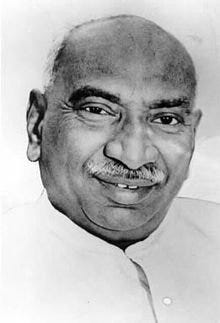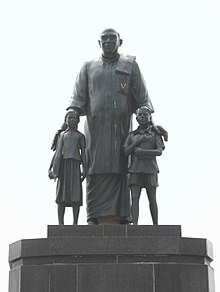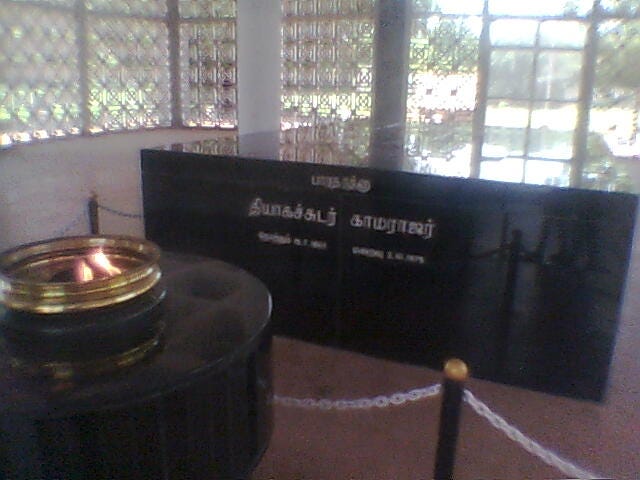Pandya Nadu or the southern most part of Tamil Nadu, basically the region covering the districts of Madurai, Theni, Sivaganga, Ramanthapuram, Virudhunagar, Tirunelveli, Thoothukudi and Kanyakumari. A region of rich culture, heritage and history. A land of magnificient temples, beautiful coastlines, breathtaking natural vistas.
This land of the Pandyas, has also produced some of the greatest freedom fighters and revolutionaries too. The legendary Veera Pandya Kattabomman, the great freedom fighter who had the vision to set up a shipping company, V.O.Chidambaram Pillai , the firebrand revolutionary poet Subramanya Bharati and Pasumpon Muthuramalinga Thevar, one of Netaji’s closest associates hailed from this region.
And to such an illustrious pantheon, belonged one of the finest political leaders ever of Tamil Nadu,whose nine year reign as Chief Minister, laid the foundation for it’s educational and economic growth, Kamaraj also called as Kalvi Thanthai( Father of Education).
His vision was astonishingly ahead of its time: rather than focus on elite institutions, he democratized education, bringing learning into every village and classroom.
His Midday Meal Scheme didn’t just fill stomachs, it filled futures. His push for universal schooling wasn’t just about literacy,it was about dignity and opportunity.
And his humility in stepping down as Chief Minister to focus on strengthening the Indian National Congress, that’s statesmanship few can match. And his crucial role in the establishment of two Prime Ministers- Lal Bahadur Shastri and Indira Gandhi earned him the ephithet of “King Maker”.
This great man was born on July 15, 1903 in Virudhunagar to Kumaraswamy Nadar, a merchant and Sivakami, was originally named as Kamatchi, after the family deity. With his mother affectionately calling him as Raja, he began to be called as Kamarajar later on.
Enrolled in a traditional school in 1907, he would join the Yenadhi Narayana Vidhya Sala the next year. However with the sudden death of his father, when he was just 6 years old, he had to drop out to support his mother, working in his uncle’s provision shop. It was these childhood experiences, that made him realize the importance of education when he later became the Chief Minister.
His early activism wasn’t just reactive; it was deeply intentional, shaped by the voices of Varadarajulu Naidu, George Joseph, and Kalyana Sundara Mudaliar, who gave him ideological grounding.
At just 16, the Jallianwala Bagh massacre shook him to his core, turning grief into resolve. By 1920, he was a full-time member, organizing meetings and distributing Gandhi’s speeches around Virudhunagar. In 1921, that encounter in Madurai wasn’t just symbolic—it was catalytic. Gandhi’s ideals became Kamaraj’s compass.
He joined the boycott in Madras, standing shoulder to shoulder with fellow satyagrahis. And in the Nagpur Flag Satyagraha,helped mobilize support against British bans on the national flag, showing early signs of his organizational brilliance.
This wasn’t just political awakening—it was the birth of a lifelong mission. His activism was raw, unpolished, and deeply personal. And yet, it laid the foundation for the statesman he would become.
Kamaraj’s arrest in 1930 for the Salt Satyagraha marked his first major imprisonment. He joined 150 satyagrahis in the coastal protest at Vedaranyam, echoing Gandhi’s Dandi March. He was arrested again in 1932 for leading demonstrations against Gandhi’s detention, sentenced to a year of rigorous imprisonment.
Falsely implicated in Virudhanagar bomb case in 1933, he faced intense pressure from British authorities. But with Varadarajulu Naidu and George Joseph defending him, he was acquitted—though he had to sell most of his ancestral property to fight the case.
When Satyamurthy became TNCC President in 1936, Kamaraj was appointed Secretary, solidifying his role as a key strategist. He won from Sattur constituency in 1937, entering the Madras Legislative Assembly unopposed, marking his transition from activist to legislator.
Rajaji’s Modified Scheme of Elementary Education, introduced in 1953, was intended to blend Gandhian ideals of craft-based learning with formal education. But the execution—reducing school hours and sending children home to learn family vocations—was seen by many as regressive and caste-reinforcing.
Rajaji bypassed cabinet consultation, sparking dissent even within the Congress. Parties like DMK and Dravidar Kazhagam condemned it as Kula Kalvi Thittam, arguing it would entrench caste-based professions and deny upward mobility. Demonstrations, petitions, and legislative pushback intensified. Teachers’ unions also opposed the scheme due to increased workload without compensation.
Kamarajar, sensing the public mood and internal unrest, withdrew support. In 1954, he decisively defeated C. Subramaniam to become President of the Madras Legislature Congress Party.Rajaji resigned, and on April 13, 1954, Kamaraj was sworn in as Chief Minister—ushering in a new era focused on inclusive education and social upliftment.
Kamarajar’s leadership wasn’t just visionary, it was deeply humane. His decision to include C. Subramaniam and M. Bhaktavatsalam in his cabinet, despite prior political rivalry, speaks volumes about his statesmanship and ability to prioritize merit over ego.
Every village got a primary school, and every panchayat a high school. He made sure no child had to walk more than 3 km to reach a classroom. Up to the 11th standard, education was not just available, it was a right.
The mid-day meal became the bridge between poverty and possibility. It boosted enrollment, reduced dropouts, and even fostered social unity. Free school uniforms was a subtle but profound move, erasing visible markers of caste and class, and nurturing equality among students.
Kamaraj didn’t just build schools, he built dignity, opportunity, and unity. His legacy is stitched into every classroom, every lunch plate, every uniform.
His reforms were holistic, targeting both access and excellence. Scrapping unnecessary holidays and increasing working days might seem mundane, but it reflected his belief that every classroom hour mattered. And the revised syllabus wasn’t just academic, it was aspirational, designed to unlock each child’s potential.
His role in establishing IIT Madras in 1959, alongside Governor Bishnuram Medhi, was very significant . It signaled that Tamil Nadu wouldn’t just educate its masses,it would also nurture its brightest minds in science and technology. The numbers spoke, literacy rising from 7% to 37% during his tenure, not just progress, it was a transformation.
Kamarajar ’s irrigation and industrial initiatives were nothing short of revolutionary, they stitched together the economic backbone of Tamil Nadu.
Bhavanisagar, Erode, one of the world’s largest earthen dams, completed in 1955, that irrigated over 840 sq km of farmland across Erode, Tiruppur, and Karur districts.
Though Mettur dam was built earlier, Kamaraj expanded its reach through canal systems and desilting, benefiting 180 sq km of land.
The Vaigai, Sathanur Dams opened up cultivation in Madurai, Theni, and Tiruvannamalai, turning arid zones into fertile belts. Between 1957–61, 1,700 tanks were desilted, 2,000 wells dug, and farmers received long-term loans with 25% subsidy—a lifeline for rural prosperity.
Neyveli Lignite Corporation, a landmark in energy and mining, powered Tamil Nadu’s industrial growth and created thousands of jobs. BHEL, Trichy a cornerstone of India’s heavy electrical manufacturing, it positioned Tamil Nadu as a hub for engineering excellence.
While Hindustan Photo Films at Ooty, boosted the state’s presence in precision manufacturing and technology. And the Integral Coach Factory at Perambur, revolutionized rail infrastructure, producing coaches that still run across India today.
Kamaraj didn’t just build dams and factories—he built self-reliance. His policies turned Tamil Nadu into a model of balanced development, where agriculture and industry walked hand in hand.
He went on to become one of the longer serving CMs in Tamil Nadu, serving two more back to back terms in 1957 and 1962. However noticing that the Congress party was slowly losing it’s hold over the state, with the rise of the Dravidian parties, he resigned in 1963 on Gandhi Jayanti, and also proposed that all senior Congress leaders should resign from their posts and devote their energy to the party’s revitalization.
The Kamaraj Plan was a bold, self-sacrificial move that asked senior Congress leaders to step down from ministerial posts and return to grassroots organizing. It was his way of saying: “Power must serve purpose, not perpetuate itself.”
His journey from a grassroots organizer to a national strategist is one of the most compelling arcs in Indian political history.
His refusal to become Prime Minister, despite being the architect behind two transition, speaks volumes about his humility and commitment to the party over personal ambition.
The 1971 elections were indeed a turning point. After the Congress split in 1969, Kamaraj led the Congress (Organisation) in Tamil Nadu, but the faction was no match for Indira Gandhi’s populist wave and her strategic alignment with DMK in the state.
Congress(O) won only 16 Lok Sabha seats nationwide, while Indira’s Congress(R) secured a staggering 352 seats, riding high on the post-war sentiment and her “Garibi Hatao” campaign.
Kamaraj’s passing on Gandhi Jayanti, October 2, 1975, felt symbolically fitting—it marked not just the end of a life, but the culmination of a legacy rooted in Gandhian values. He died in his sleep at age 72, leaving behind just ₹130, four shirts, four dhotis, two pairs of sandals, and a few books. That simplicity wasn’t performative—it was who he was.
His posthumous Bharat Ratna in 1976 was more than an award—it was a nation’s salute to a man who gave everything and asked for nothing.
His legacy lives on in many ways, the primary school network in Tamil Nadu, the industries, his memorial at Marina Beach, and Kamarajara Salai, the road near to the beach, the domestic terminal at Chennai airport named after him.







These writeups are awesome.